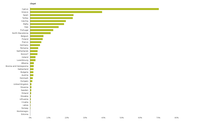
WEI+ illustrates the percentage of water use against renewable freshwater resources in a given time and place

Emissions, allowances, surplus and prices in the EU ETS, 2005-2020

This figure shows a time series of carbon emissions under the EU ETS for the main activity codes.

* Emissions from combustion installations (Activity Code 20)
** Thermal electricity generation from other sources (e.g. oil, renewables, waste) are not shown here.
*** No data available on electricity generation for Iceland and Liechtenstein

Land take and the associated soil sealing causes less resilient ecosystems through landscape fragmentation and habitats destruction, soil sealing, decreased carbon sequestration and impaired flood protection. These processes are one of the major drivers of land degradation. Restoring wetlands, peatlands, coastal ecosystems, forests, grasslands and agricultural soils are essential for avoiding biodiversity decline and for climate change adaptation. This dashboard presents an overview of land take processes in protected areas of Functional Urban Areas in EEA and EU member states for the years 2012-2018.

Land take and the associated soil sealing causes less resilient ecosystems through landscape fragmentation and habitats destruction, soil sealing, decreased carbon sequestration and impaired flood protection. These processes are one of the major drivers of land degradation. Restoring wetlands, peatlands, coastal ecosystems, forests, grasslands and agricultural soils are essential for avoiding biodiversity decline and for climate change adaptation. This dashboard presents an overview of land take processes in floodplains of Functional Urban Areas in EEA and EU member states for the years 2012-2018.

Land take and the associated soil sealing causes less resilient ecosystems through landscape fragmentation and habitats destruction, soil sealing, decreased carbon sequestration and impaired flood protection. These processes are one of the major drivers of land degradation. Restoring wetlands, peatlands, coastal ecosystems, forests, grasslands and agricultural soils are essential for avoiding biodiversity decline and for climate change adaptation. This dashboard presents an overview of land take processes in Functional Urban Areas in EEA and EU member states for the years 2012-2018. The amount of land take was derived from the Urban Atlas datasets of the Copernicus Land Monitoring Service.

Green infrastructure in urban areas consist of vegetated green surfaces, such as parks, trees and small forests, grasslands, but also private gardens or cemeteries. These all contribute to supporting biodiversity, pollinators, carbon sequestration, flood protection and protection against excess heats events. This dashboard facilitates the understanding of the amount of urban green in Functional Urban Areas of the EU and EEA member states.

Climate change assessment of the Fire Weather Index (FWI) aggregated component, computed daily from 1980 to 2100 for five models (see Table 4 of de Rigo et al., 2017 https://doi.org/10.2760/13180 ). The daily FWI is computed for each scenario realisation based on a corresponding model. The entire time series has been estimated (from the end of the control period, the scenario RCP8.5 has been used) and the 90 % quantile of each time period has been computed. The median of the five model ensemble is shown for each period.

These country fact sheets summarise information on noise pollution for selected EEA member countries. The fact sheets are based on the latest official noise data reported every five years by EEA member countries under the Environmental Noise Directive (END).

These country fact sheets summarise information on noise pollution for selected EEA member countries. The fact sheets are based on the latest official noise data reported every five years by EEA member countries under the Environmental Noise Directive (END).

These country fact sheets summarise information on noise pollution for each of the EEA-33 member countries. The fact sheets are based on the latest official noise data reported every five years by EEA member countries under the Environmental Noise Directive (END).